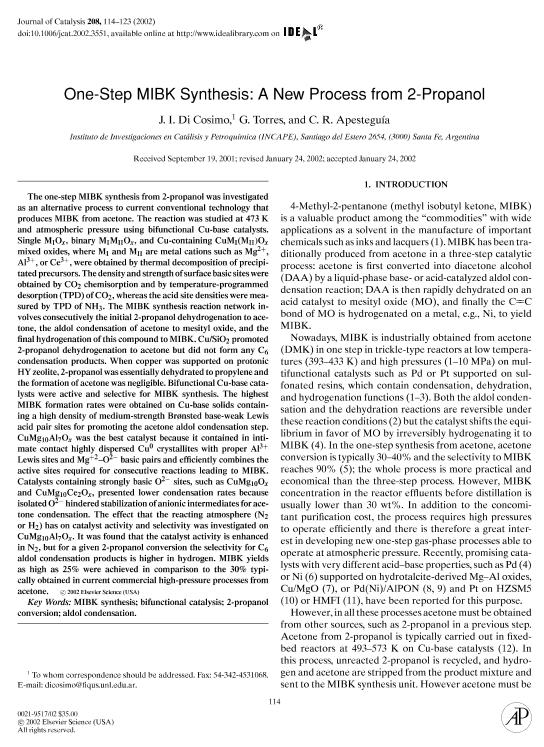Artículo
One-Step MIBK Synthesis: A New Process from 2-Propanol
Fecha de publicación:
05/2002
Editorial:
Elsevier Science
Revista:
Journal of Catalysis
ISSN:
0021-9517
Idioma:
Inglés
Tipo de recurso:
Artículo publicado
Clasificación temática:
Resumen
The one-step MIBK synthesis from 2-propanol was investigated as an alternative process to current conventional technology that produces MIBK from acetone. The reaction was studied at 473 K and atmospheric pressure using bifunctional Cu-base catalysts. Single MIOx, binary MIMIIOx, and Cu-containing CuMI(MIIOx mixed oxides, where MI and MII are metal cations such as Mg2+, Al3+, or Ce3+, were obtained by thermal decomposition of precipitated precursors. The density and strength of surface basic sites were obtained by CO2 chemisorption and by temperature-programmed desorption (TPD) of CO2, whereas the acid site densities were measured by TPD of NH3. The MIBK synthesis reaction network involves consecutively the initial 2-propanol dehydrogenation to acetone, the aldol condensation of acetone to mesityl oxide, and the final hydrogenation of this compound to MIBK. Cu/SiO2 promoted 2-propanol dehydrogenation to acetone but did not form any C6 condensation products. When copper was supported on protonic HY zeolite, 2-propanol was essentially dehydrated to propylene and the formation of acetone was negligible. Bifunctional Cu-base catalysts were active and selective for MIBK synthesis. The highest MIBK formation rates were obtained on Cu-base solids containing a high density of medium-strength Brønsted base-weak Lewis acid pair sites for promoting the acetone aldol condensation step. CuMg10Al7Ox was the best catalyst because it contained in intimate contact highly dispersed Cu0 crystallites with proper Al3+ Lewis sites and Mg+2–O2− basic pairs and efficiently combines the active sites required for consecutive reactions leading to MIBK. Catalysts containing strongly basic O2− sites, such as CuMg10Ox and CuMg10Ce2Ox, presented lower condensation rates because isolated O2− hindered stabilization of anionic intermediates for acetone condensation. The effect that the reacting atmosphere (N2 or H2) has on catalyst activity and selectivity was investigated on CuMg10Al7Ox. It was found that the catalyst activity is enhanced in N2, but for a given 2-propanol conversion the selectivity for C6 aldol condensation products is higher in hydrogen. MIBK yields as high as 25% were achieved in comparison to the 30% typically obtained in current commercial high-pressure processes from acetone.
Archivos asociados
Licencia
Identificadores
Colecciones
Articulos(INCAPE)
Articulos de INST.DE INVEST.EN CATALISIS Y PETROQUIMICA "ING. JOSE MIGUEL PARERA"
Articulos de INST.DE INVEST.EN CATALISIS Y PETROQUIMICA "ING. JOSE MIGUEL PARERA"
Citación
Di Cosimo, Juana Isabel; Torres, Gerardo Carlos; Apesteguia, Carlos Rodolfo; One-Step MIBK Synthesis: A New Process from 2-Propanol; Elsevier Science; Journal of Catalysis; 208; 1; 5-2002; 114-123
Compartir
Altmétricas




